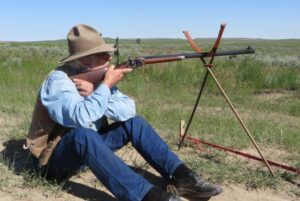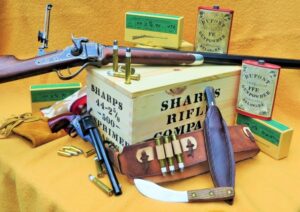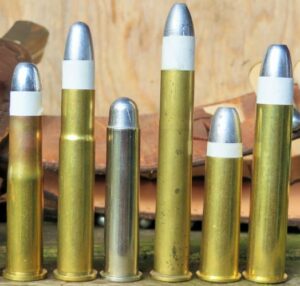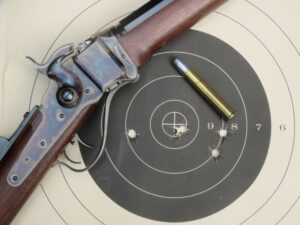
By Mike Nesbitt | Contributing Editor
For me, the .44/90 Sharps rifle was a real favorite even before I got one. The reason for that is because Elmer Keith used one that he got from an old buffalo hunter and he used it with great success in the local rifle matches, often loading it with 105 grains of black powder. (That’s a top load for the .44/90, usually with a 500 grain bullet.)
Elmer also talked about the paper patched bullets he used which were sometimes given three wraps of paper instead of the usual two. The stories Elmer could spin about his early Sharps shooting stayed with me and those are probably the roots of why I still favor the Sharps .44s.
When I say “the Sharps .44s” I do mean the .44/77 as well as the .44/90 and I’ll even include the modern “wildcat,” the .44/70 C. Sharps Straight which is simply a .45/70 necked or tapered down to take the .446-inch diameter Sharps .44 caliber bullets.

The history of the Sharps .44s is interesting and involved. As an example, the old International 1000 yard matches such as those shot at the Creedmoor range were won with the .44 caliber Sharps cartridges, in either the Sharps rifles or the Remington rolling blocks and the specific caliber was usually noted as a .44/90. However, those .44/90s were loaded in the 2 ¼” bottleneck case and that’s the standard case for the .44/77. Those were loaded for target shooting only and they were called the “.44/90 Regular.”
There were other .44/90s too; Remington had at least two other cartridges carrying that name. One was a special bottlenecked cartridge with a case length of 2 7/16-inches which was called the .44/90 Remington Special. The other was the .44/90 Remington Straight which had either a 2.4 or 2.6-inch long (.44/100) straight case. All of the Remington .44/90 caliber cartridges were primarily designed for long range target work.

The .44/90 Sharps with the 2 5/8-inch bottleneck case, which is really our main subject, was introduced in 1873 for the buffalo hunters, giving those hunters a cartridge with greater effectiveness for long range shooting. Its original hunting load included a 450 grain paper patched bullet over 90 grains of black powder. A short time later, bullets of 500 grains were available and the powder charge could be increased to 105 grains for more ‘bounce to the ounce.’ For accuracy, especially with the 520 grain bullets for “target work” it was said that the big .44 could do at 1000 yards what the .50s could do at 600…
To say the .44/90 was popular would be telling the truth but that would only be true for a small group of shooters, primarily the buffalo hunters. In more general terms, the .44/90 Sharps was not a popular cartridge and actually rather few of them were made. In 1876 the Sharps rifle company was re-organized, moved from Hartford to Bridgeport, and the .45 caliber rifles became the new standard while the .44s and the .50 caliber Sharps rifles were discontinued. That means the .44/90 enjoyed a short life of only about four years as a standard Sharps chambering.
And the .44/90 Sharps is considered to be a heavy recoiling rifle. Everyone who has talked about shooting a rifle in this caliber has mentioned the recoil. All I can say about that now is how you learn to ‘roll with the punch’ and not let it hurt you. That is at least one reason why I titled this article “Getting a kick out of the .44/90 Sharps.” It’s a big rifle, what else can we say?

My own Sharps in .44/90 came to me in 2013 and that was after I had asked C. Sharps Arms if they had a # 1 ½ Heavy barrel in .44 caliber in stock. I was told such a barrel was waiting there and then I asked them to put my name on it. Following that, the other details of what the rifle should look like were ironed out. What I wanted was a rifle that had the look of a buffalo gun, heavy, rather plain, and certainly a serious looking rifle.
With those things in mind, the gun was ordered to be a Hartford Model 1874 with a # 1 ½ Heavy barrel, 32 inches long, with the famous Hartford collar just ahead of the receiver. The barrel was to be given a dovetail for the front sight but no dovetail for a rear sight. The receiver group which includes the lockplate, trigger plate and trigger guard plus the buttplate was to be pack-hardened which is an extra (adding $350 to the price of the rifle) but it adds so much to the appearance of the gun. To add just a little bit of contrast to the blue of the barrel and the pack-hardening of the receiver group, I asked that brass escutcheons be added under the screws for the forearm and the lock screw on the left side of the wrist. The barrel’s only dovetail near the muzzle was filled with a globe sight with changeable apertures plus a spirit level. The long range rear sight was added after the rifle was delivered.
Let me say how delighted I was with the new rifle, from its general appearance to the fit and finish of its individual parts. I simply sat and held this rifle for a good long time right after I got it. This gun is most certainly a reflection of the picture I had in my mind, a buffalo hunter’s rifle. And it weighed, with the long range sight installed, a trim 14 pounds.
Shooting the new gun followed very shortly afterward. I used both paper patched and grease-groove bullets, with the grease-groove bullets getting most of my assignments. My favorites were the 470 and 480 grain bullets with powder charges of at least 90 grains. I also used powder charges of 95 or 100 grains, depending on how things were going at the time, but charges using less than 90 grains simply did not work. To put things in a nutshell, the shooting was good and my .44/90 was giving me my top scores.
One example I’ll give was at one of our club’s Old West Centerfires matches which has targets at 100 and 200 yards, fired at from the sitting position while using cross-sticks. That’s “short range” shooting for a Sharps but it is still a lot of fun and very competitive. We shoot ten shots at each distance for a possible of 200 points and with my .44/90 I turned in a 94-XX at 100 yards and a 94-X at 200 yards for a score that day of 188-3X. That was a winner, the best I’ve ever done in the Old West Centerfires matches.
Over the years my shooting with the .44/90 has been a repeat of load development. When I started with this caliber, the powder I liked was GOEX “Cartridge” which I used until “Cartridge” was discontinued. That’s my powder of choice because KIK 1 ½ Fg and shortly after my rifle developed a real liking for that powder, it was also discontinued. So, loads were tried using the then new GOEX Olde Eysnford powder in the 1 ½ F granulation. That was excellent powder and now the closure of the GOEX powder plant has been announced. To put things simply, another powder needed to be tried and that was Swiss black powder in the 1 ½ Fg granulation.

To give this powder a really good try, just five rounds were loaded using 90 grains of the Swiss 1 1/2 Fg powder under 480 grain bullets from Accurate Molds’ #44-470N design. The bullets were lubed with BPC (Black Powder Cartridge) lube from C. Sharps Arms, and the powder was ignited with CCI #200 standard large rifle primers. A .060” veggie wad from John Walters separated the bullets from the powder. The loads were contained in Jamison .44/90 Sharps brass, which is unfortunately no longer available.
Those five rounds were taken to the range and fired, from the bench, at a standard 100-yard target. No spotting was done and I didn’t get to see the target until I walked out to the 100-yard line to fetch it after the shooting was done. To my delight, the target held two X’s and three 9s, for a score of 47-2X. I wish my shots had been spotted shot after shot because I to have a little belief. My thought is that the two X’s were the first two shots and my group might have been tighter if I had wiped the barrel after two shots. Swiss powder has a harder fouling than the Olde Eynsford and some wiping of the bore between shots or every two shots should have tightened the group.
We’ll just have to see about that… My .44/90’s performance with those five shots reminded me of a couple of things. One, how well that rifle has performed for me over the years, and two, that we have this year’s final Old West Centerfires match coming in just two weeks as this is written. So I will prepare the ammo to use my heavy .44/90 in that match. To let you know how things went, my next story will be a complete report on that Old West Centerfires match with a listing of all the guns that were used.



